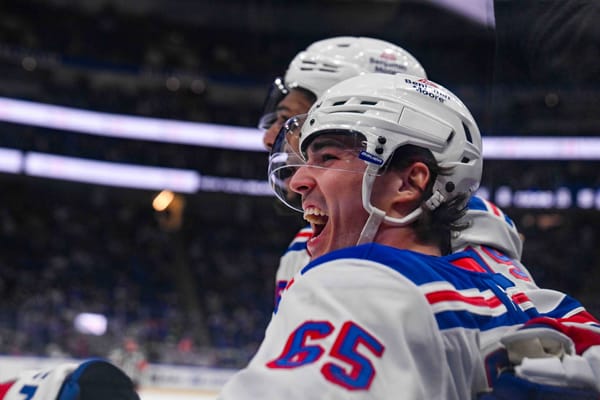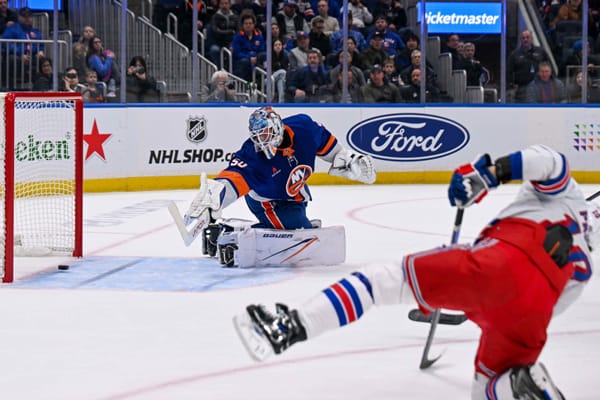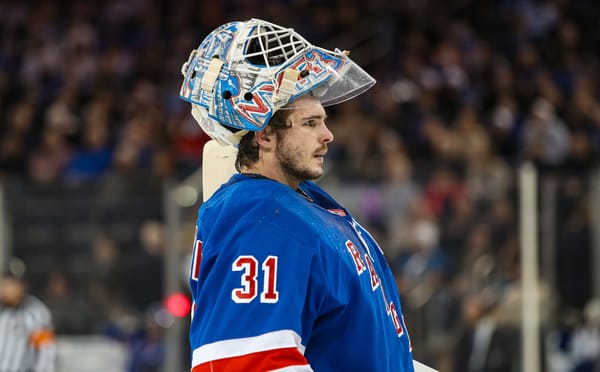Without Top Picks, Rangers Rebuild Follows Old Adage And New Trend
As the old adage in hockey goes, you build a team from the net out. That means you start by finding a solid goalie, then you build solid defense, and then build strength down the middle at the center position. The theory here is that by preventing goals with solid defense and goaltending, you can begin to win games. Building down the middle with good centers drives your offense. Centers are generally creative with the puck, and can drive your even strength and special teams play. Centers are also fully capable of adjusting to either wing, making them more versatile in filling team needs. Transitioning from wing to center is doable, but much more difficult.
Many of the recent Stanley Cup teams have followed this formula. The 2010 Blackhawks were defined by solid defense, great centers (most of whom managed to stay with the Blackhawks after the season), and a hot goalie in Antii Niemi. The 2009 Penguins had Sidney Crosby and Evgeny Malkin down the middle, with a good defense and great goaltending. The 2008 Red Wings were built the same way. It is a trend that simply cannot be ignored. During the current rebuild, the Rangers have followed this trend, and may look to share the same success soon.
Starting in net, the Rangers struck gold with Henrik Lundqvist. However, when the rebuild started with the 2004 fire sale, the Rangers had no idea what they had in Lundqvist. If they knew that Lundqvist would become The King, then they wouldn’t have looked to address their goalie situation by selecting Al Montoya with the sixth overall pick in the 2004 draft. At the time, it was a solid pick. Naturally, it didn’t work out as planned, but it didn’t matter that much as the Rangers are now set with Lundqvist in net for the foreseeable future.
General Manager Glen Sather and company, which currently includes the likes of Gordie Clark and Jim Schoenfeld, and had included Don Maloney and Tom Renney, then looked to address the defense. The 2005, 2006, and 2008 drafts all ended with the Rangers selecting a defenseman in the first round. Luckily for the Rangers, two of those three worked out fairly well in Marc Staal and Michael Del Zotto. The 2006 pick, Bobby Sanguinetti, didn’t work out. To quote Meatloaf, two out of three ain’t bad. The Rangers also managed to find another diamond in the rough, much like Lundqvist, in Dan Girardi. The undrafted free agent has been a rock on defense for the Rangers, and will continue to be one for years to come.
With only three core pieces defined, the Rangers then stole Ryan McDonagh (a 2007 first round pick) away from Montreal, and used their 2010 first round pick to select Dylan McIlrath. If all pans out, then the Rangers will have a whopping four first round draft picks playing on their blue line. Each defenseman has their own defined role, which makes the defense that much more balanced. Del Zotto is projected to be the offensive defenseman who quarterbacks the first powerplay unit. Staal is projected to be the best defenseman on the team, and maybe quarterback the second powerplay. Girardi and McDonagh are those steady defenders who are positionally sound. McIlrath is the big bruiser. With those core pieces in place, and with The King in net, the Rangers look to be incredible stingy for years to come.
The Rangers also started building the center depth beginning with the 2004 draft. Unlike defense, the Rangers felt they could land high quality center talent after the first round, and it looks like they were right. The Rangers took centers in the second round in 2004 (Brandon Dubinsky), 2005 (Marc-Andre Cliche), 2006 (Artem Anisimov), 2008 (Derek Stepan), and 2009 (Ethan Werek). With the exception of Werek, who is still playing in Juniors, all have made significant contributions to the Rangers, whether it was direct or indirect (Cliche was the centerpiece of the trade that brought Sean Avery to Manhattan). The Ranger also took Chris Kreider (first round, 2009) and Evgeny Grachev (third round, 2008), both of whom are capable of playing center.
With depth at the center position clearly established, the roster needed to be filled out with core pieces and role players. The Rangers already have Ryan Callahan (fourth round, 2004). Players like Grachev, Dale Weise (fourth round, 2008), and Mats Zuccarello-Aasen (undrafted free agent) in the AHL. All three have seen at least one game with the Rangers this year. Prospects Carl Hagelin (sixth round, 2007), Ryan Bourque (third round, 2009), Roman Horak (fifth round, 2009), and Christian Thomas (second round, 2010) have all been mentioned by name by Sather in regards to the strength of the farm.
Not all pieces come via the draft. The one thing Ranger fans have learned is that Glen Sather is a master at the art of the trade. The Rangers struck gold when they sent Ales Kotalik and Chris Higgins to Calgary for Olli Jokinen, and a throw-in by the name of Brandon Prust. Sather is also starting to look good for giving Los Angeles a third round pick for Brian Boyle, another center. Prust and Boyle are having breakout years, and coach John Tortorella has said that Prust has become a part of the core of the team. If Boyle continues to produce the way he has been this season, he will soon become a part of the core as well.
A hot goalie can steal a playoff series. A hot goalie with a well balanced blue line can win a few playoff series. Combine those with core centers with the talent to drive the offense, and wingers that fit in nicely with the system, and you have yourself a Stanley Cup competitor. The Rangers rebuild may have taken longer than most will have liked, but in post-lockout hockey, it’s tough to argue with the results. The pieces are there, the high end talent is en route, and the players are beginning to buy into the coaches system and build chemistry. All of these together fuel the jet to success. For Ranger fans, it may not be a matter of if the pieces fall together, but when.




